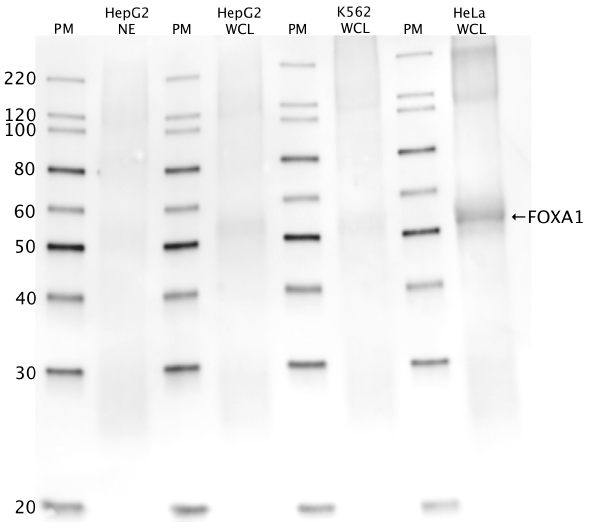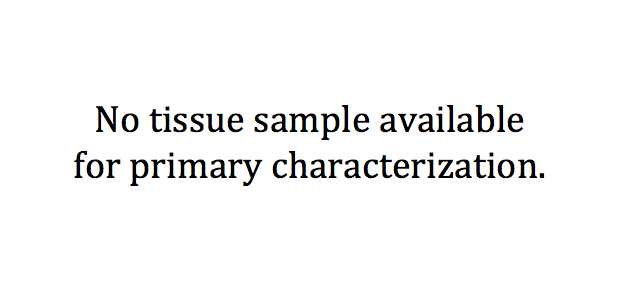ENCAB000AGN
Antibody against Homo sapiens FOXA1
Homo sapiens
HeLa-S3, liver
characterized to standards with exemption
- Status
- released
- Source (vendor)
- Santa Cruz Biotech
- Product ID
- sc-6553
- Lot ID
- H1209
- Characterized targets
- FOXA1 (Homo sapiens)
- Host
- goat
- Clonality
- polyclonal
- Isotype
- IgG
- Antigen description
- Epitope mapping at the C-terminus of FOXA1 of human origin
- External resources
Characterizations
FOXA1 (Homo sapiens)
Method: motif enrichment
compliant
- Caption
- The motif for target FOXA1 is represented by the attached position weight matrix (PWM) derived from files ENCFF165AIU and ENCFF656OEP. Motif enrichment analysis was done by Dr. Zhizhuo Zhang (Broad Institute, Kellis Lab) using known motifs (http://compbio.mit.edu/encode-motifs/) and previously published ChIP-seq data (http://www.broadinstitute.org/~zzhang/motifpipeline/data/TrainSetInfo.txt). The accept probability score of the given transcription factor was calculated using a Bayesian approach. This analysis also includes three motif enrichment scores, computed by overlapping the motif instances with the given ChIP-seq peak locations. For more information on the underlying statistical methods, please see the attached document. From ENCFF165AIU: Accept probability score: 0.920250256253, Global enrichment Z-score: 5.42074566454, Positional bias Z-score: 10.0019804562, Peak rank bias Z-score: 9.74776916165. From ENCFF656OEP: Accept probability score: 0.920250256253, Global enrichment Z-score: 7.21927335273, Positional bias Z-score: 10.8336434073, Peak rank bias Z-score: 9.83460513054, Enrichment rank: 1.0.
- Submitted by
- Aditi Narayanan
- Lab
- Richard Myers, HAIB
- Grant
- U54HG006998
- Download
- ENCAB000AGN.pdf
FOXA1 (Homo sapiens)
Method: ChIP-seq comparison
not reviewed
- Caption
- Validation 2: Immunoprecipitation with multiple antibodies against different parts of the target protein ENCODE data standards allow for secondary validation of antibodies by performing ChIP with multiple antibodies against different parts of the target protein. A statistically significant overlap of targets constitutes validation. FOXA1 (C-20) sc-6553 is a goat polyclonal antibody, with epitope mapping at the C-terminus of FOXA1 of human origin. A second antibody used in ChIP-seq experiments on FOXA1 in our lab is FOXA1 (Q-6) sc-101058, a mouse monoclonal antibody raised against recombinant FOXA1 of human origin. Irreproducible Discovery Rate (IDR) analysis results for two ChIP-seq experiments using these two antibodies, each in HepG2, are as follows: At IDR 0.01: 14930 peaks are significant At IDR 0.05: 18842 peaks are significant At IDR 0.1: 21519 peaks are significant These results indicate significant overlap between the two ChIP-seq libraries.
- Submitted by
- Richard Myers
- Lab
- Richard Myers, HAIB
- Grant
- U54HG004576
- Documents
FOXA1 (Homo sapiens)
HeLa-S3
exempt from standards
- Caption
- Western blot protocol: Whole cell lysate was immunoprecipitated using primary antibody, and the IP fraction was loaded on a 12% acrylamide gel and separated with a Bio-Rad PROTEAN II xi system. After separation, the samples were transferred to a nitrocellulose membrane with an Invitrogen iBlot system. Blotting with primary (same as that used for IP) and secondary HRP-conjugated antibodies was performed on an Invitrogen BenchPro 4100 system. Visualization was achieved using SuperSignal West Femto solution (Thermo Scientific). Results: Band of expected size visualized, representing strongest signal in the lane. Figure legend: IP-western with sc-6553 in nuclear extract (NE) of HepG3 and in whole cell lysate (WCL) of HepG2, K562 and HeLa; PM=protein marker. FOXA1 bands are indicated.
- Submitter comment
- --
- Reviewer comment
- The antibody review panel will pass (with exemption) any immunoprecipitation characterization that meets all standards for ENCODE2. ENCODE2 did not require an IgG control
- Submitted by
- Richard Myers
- Lab
- Richard Myers, HAIB
- Grant
- U54HG004576
FOXA1 (Homo sapiens)
liver
exempt from standards
- Caption
- The ENCODE Binding Working Group finds for some valuable tissues that recreating a primary on well characterized antibodies is not cost effective. Therefore, they allow exemption from standards for these tissues.
- Submitter comment
- The lab is asking for an exemption for liver cells due to the lack of resource to make a primary characterization for them
- Reviewer comment
- Exempted by the Feb 29, 2016 antibody review panel
- Submitted by
- Richard Myers
- Lab
- Richard Myers, HAIB
- Grant
- U54HG006998
- Download
- No_tissue.png

